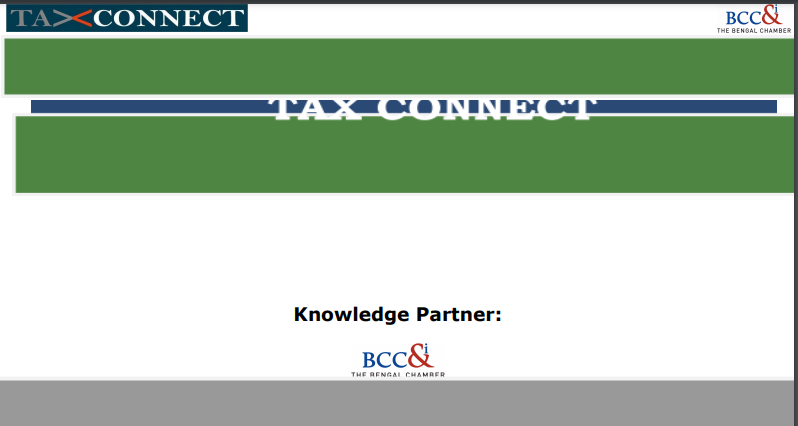304th Issue of Tax Connect
Tax Calendar
| Due date | Form/Return/Challan | Reporting Period | Description |
| 30th June 2021 | Form 26QB | May 2021 | Challan-cum-statement in respect of tax deducted under section 194-IA. |
| 30th June 2021 | Form 26QC | May 2021 | Challan-cum-statement in respect of tax deducted under section 194-IB. |
| 30th June 2021 | Form 26QD | May 2021 | challan-cum-statement in respect of tax deducted under Section 194M. |
| 30th June 2021 | Form: 26QAA | May 2021 | Quarterly return of non -deduction at source by a banking company from interest on deposit in respect of the quarter ending |
| 30th June 2021 | FY 2020-21 | Linking of Aadhar with PAN | |
| 30th June 2021 | Form 61A | FY 2020-21 | Taxpayers who are required to file Statement of Specified Financial Transactions ( SFT ) |
Income Tax
Circular
Circular No. 11/2021, Dated 21st June 2021 Circular Regarding Use Of Functionality Under Section 206ab And 206cca Of The Income-Tax Act, 1961
Our Comments: Referring to Circular No. 11 of the Year 2021 issued by CBDT. We would discuss some of the bullet points given under point no. 3 titled as “logic of the functionality” of the above-mentioned circular.
1. “During the financial year 2021-22, no new names are added to the list of specified persons. This is a taxpayer-friendly measure to reduce the burden on tax deductor and collector of checking PANs of non-specified person more than once during the financial year.”
Related Topic:
306th Issue of Tax Connect
Consider the following example:
In the situation given above, a person will not be considered as a “Specified Person” as of 01/04/2021, if he has filed a return for FY 2018-19 by that date. But immediately on 01/10/2021 (when due date 30/09/2021 will expire to file a return for FY 2020-21), he must have to be declared as a “Specified Person”.
How such relaxation can be given by CBDT which is not looking consistent with the legal provisions contained in sub-section (1) and (3) of sections 206AB and Section 206CCA?
2. If any specified person files a valid return of income (filed & verified) for the assessment year 2019-20 or 2020-21 during the financial year 2021-22, his name would be removed from the list of specified persons. This would be done on the date of filing of the valid return of income during the financial year 2021-22
Now, suppose a case where the return of income is filed for FY 2018-19 (AY 2019-20) during FY 2021-22 on 01/10/2021 [suppose in response to notice issued under 142(1)]. But the same person has not filed a return of income for both FY 2019-20 and FY 2020-21, so as of 01/10/2021, he must be continued to be classified as a “Specified Person”.
Related Topic:
308th Issue of Tax Connect
| Financial Year | 139(1) Limit Expired | Return filed? |
| FY 2021-22 | ||
| FY 2020-21 | No | No |
| FY 2019-20 | Yes | No |
| FY 2018-19 | Yes | Yes |
- Further, to calculate the aggregate amount of TDS/TCS (Rs. 50,000 or more), obviously, their system would fetch the data from Form No. 26AS. Now what to do if someone erroneously enters our PAN in his TDS/TCS return and we get an erroneous credit in our Form No. 26AS.
Thus, it is quite clear from the above-mentioned points that matters of the above-mentioned circular must be again considered for proper modification and if needed, the amendment should also be brought into relevant sections of the Income Tax Act, 1961 also.
[For further details please refer to the circular].
GST
Circular
Circular No. 156/12/2021-GST- CBEC-20/16/38/2020 –GST, Clarification In Respect Of Applicability Of Dynamic Quick Response (Qr) Code On B2C Invoices And Compliance Of Notification 14/2020- Central Tax Dated 21st March 2020
Our Comments: Clarification has been issued on applicability of Dynamic Quick Response (QR) Code on B2C (Registered person to unregistered Customer) invoices and compliance of notification 14/2020-Central Tax, dated 21st March 2020 as amended.
1. Any person, who has procured a Unique Identity Number (UIN) shall not come within the domain of “registered person” as per the definition of the registered person that is provided in section 2(94) of the CGST Act 2017. Hence, any invoice issued to the above-mentioned person possessing a Unique Identity Number shall be considered as an invoice issued for a Business to Consumer supply and shall also be required to obey the requirement of the Dynamic QR Code.
2. In the cases where the payment has been collected by some person who is authenticated by the supplier on his/ her behalf, the UPI ID of the said person may be provided in the Dynamic Quick Response (QR) Code, in place of the UPI ID of the supplier.
However, The Board said that wherever an invoice has been issued to a recipient located outside India, for supplying services, for which the place of supply is located in India. And this has been done as per the provisions of IGST Act 2017, and moreover, the payment has been received by the supplier in foreign currency, through RBI approved channel, the said invoice might be issued without having a Dynamic QR Code, consequentially such dynamic QR code cannot be used by the recipient who is located outside India for making payment to the supplier.
Related Topic:
Complete Guide on SFT “Specified Financial Transaction”
3. In cases, where the invoice number is unavailable at the time of the digital display of dynamic QR code specifically in the case of over-the-counter sales. In addition, the invoice number and invoices are generated after receipt of payment, the unique order ID/ unique sales reference number, which is uniquely linked to the invoice issued for the said transaction, may be provided in the Dynamic QR Code for digital display, as long as the details of such unique order ID/ sales reference number linkage with the invoice are available on the processing system of the merchant/ supplier and the cross-reference of such payment along with unique order ID/ sales reference number are also provided on the invoice.
The Board has also made a clarification that the purpose of dynamic QR Codes is to make it possible for the recipient/ customer to scan and pay the required amount to be made to the merchant/ supplier in respect of the said supply.
[For further details please refer to the circular]
Customs
Circular
RBI/2021-22/56 A. P. (DIR SERIES) Circular No. 07 June 17, 2021, Liberalised Remittance Scheme For Resident Individuals – Reporting
Our Comments: The Reserve Bank of India (RBI) on June 17, 2021, has issued a circular for Reporting of Liberalised Remittance Scheme for Resident Individuals.
It has now been decided that Authorised Dealer Category-I (AD Category-I) shall collect the data in respect of the number of applications received and the total amount remitted under the Liberalised Remittance Scheme (the Scheme) through the XBRL system instead of the ORFS.
Authorized Dealer Category-I (AD Category-I) banks shall upload the requisite information on the XBRL system on or before the fifth of the succeeding month from July 01, 2021, onwards. The XBRL site can be accessed through URL https://xbrldotrbidotorgdotin/orfsxbrl. User ids are being issued separately. In case no data is to be furnished, AD banks shall upload ‘nil’ figures.
The attention of all Authorised Dealer Category – I (AD Category – I) banks is invited to A. P. (DIR Series) Circular No. 106 dated May 23, 2013, in terms of which, AD Category – I Banks were required to upload the data in respect of a number of applications received and the total amount remitted under the Liberalised Remittance Scheme (the Scheme) on Online Return Filing System (ORFS).
It has now been decided to collect this information through the XBRL system instead of the ORFS.
Accordingly, AD Category – I banks shall upload the requisite information on the XBRL system on or before the fifth of the succeeding month from July 01, 2021, onwards. The XBRL site can be accessed through URL https://xbrldotrbidotorgdotin/orfsxbrl. User ids are being issued separately. In case no data is to be furnished, AD banks shall upload ‘nil’ figures.
The directions contained in this circular have been issued under Sections 10(4) and 11(1) of the Foreign Exchange Management Act, 1999 (42 of 1999) and are without prejudice to permissions/approvals, if any, required under any other law.
[For further details please refer to the circular]
CRCL Module – Forwarding Of Samples Using Electronic Test Memo To CRCL And Other Revenue Laboratories Instruction No. 14/2021-Customs, F. No. 401/243/2016-Cus III Dated June 21st, 2021
Our Comments: The salient features of the CRCL module are as follows:
i. Customs Officers will be able to select the CRCL/other Revenue Laboratory using the ‘Lab Code’ on the basis of directories incorporated therein and generate a Test Memo for sending a sample to the said laboratory.
ii. The option of recording the drawal of samples by the Shed Examiner is also provided.
iii. Post physical receipt of the sample by the laboratory concerned, it would be accepted under acknowledgment to the Customs officer and verified to assess whether the sample is adequate for testing. If the sample is not considered adequate for testing, a return memo would be sent back to the Customs officer along with the reason for non-acceptance. The grounds for return/rejection of a test sample could be on account of improper packing, missing/ tampering Instruction No. 14/2021-Customs with seals, insufficient quantity, non-receipt of requisite technical documents or nonobservance of other test parameters, etc.
iv. If the sample is in order and is considered adequate for testing, it is allocated to any one of the Chemical Examiners in the said laboratory.
v. The date of receipt of the sample at the laboratory is provided in the system. There is also a provision of a ‘suspend queue’ to indicate reasons for delay or suspension of testing, for any reason.
vi. Post testing of the sample, the module provides the facility to enter the respective Import/Export Test Report in the system.
vii. The Customs Officer at the site would be able to view the Test Report electronically in ICES and take further action.
viii. Specific MIS reports would enable the monitoring of the pendency and time taken for sending of the Test Report by the laboratory.
4. As stated above, the use of the CRCL module is aimed at leveraging technology for bringing efficiency, transparency, and reduction in the cost of compliance for the trade-in regard to the sampling process, which impacts the clearance of import/export goods. The said module would also help in better monitoring of the sampling process for faster processing at all levels.
5. Accordingly, all field formations are hereby advised to mandatorily make use of the CRCL module to forward Test Memos for testing of samples to CRCL and other Revenue Laboratories from 01.07.2021 onwards. CRCL and other Revenue Laboratories shall not accept samples unless the Test Memo has been transmitted electronically on the CRCL module. In other words, the laboratories will not accept samples based on paper Test Memos from this date onwards. DG Systems will be separately issuing a detailed advisory on the use of the CRCL module.
6. While the use of the CRCL module is being made mandatory with effect from 01.07.2021, in case of any unforeseen systems issue/glitch that prevents the use of the said module, the sample can be accepted based on paper Test Memo, provided this is sent with the due approval of the Additional/ Joint Commissioner of Customs of the concerned field formation. This relaxation is being made so as not to hold up any clearance of import/export goods, in the event of a rare circumstance.
7. Difficulties, if any, in implementation of this instruction may be brought to the notice of the Board.
[For further details please refer to the circular]
Case Law
Kerneos Indai Aluminate Technologies Private Limited Versus Union Of India Through Its Secretary Ministry Of Commerce And Industry (Department For Promotion Of Industry And Internal Trade) And Four Others
Brief: Refusal to issue customs clearance to the High Alumina Refractory Cement imported – demand for production of BIS certificate for the goods imported by the petitioners
Our Comments: The Hon’ble High Court of Andhra Pradesh held that according to the scheme of the BIS Act and its Rules, the Bureau of Indian Standards is a National Standard Body having the technical expertise to establish national standards for goods or articles, process, system or service, etc. and it by itself has no power to enforce the implementation. On the other hand, the standards fixed under Section 10 by the Bureau, have to be notified by the Central Government and thereafter, if it considers that the standards established in respect of goods and articles mentioned in Section 14 or Section 16 shall require compulsory conformity, the Central Government shall make legislation or issue-specific order in that regard.
Notification dated 14.05.2018 was issued in terms of Rule 7(1)(b) of the Bureau of Indian Standards Rules, 1987. Under Rule 7(1)(a), the Bureau is obligated to establish Indian standards in relation to any article or process and it can amend, revise or cancel the standards so established. As per Rule 7(1)(b), all standards, their revisions, amendments, and cancellations shall be established by notification in the Official Gazette. So, in terms of Rule 7(1)(b), the standard earlier established in the year 2011 for IS:15895:2011 HARC was revised on 09.05.2018 and the same was notified in the Official Gazette by the Central Government. As per Rule 7(7)(b), this establishment of the standard is only voluntary to make it available to the public, but its conformity is not mandatory unless it is referred to in legislation or so pronounced by a specific order of the Government.
As rightly contended by the learned senior counsel for the petitioners, the respondents have not produced such a legislation or Gazette notification issued by the Central Government mandating that the standard established by BIS for IS:15895:2018 shall be compulsorily followed. Hence, the notification dated 14.05.2018 will not advance the contention of the respondents. For the same reason, another contention of the respondents that the standard specification notification issued by BIS should be deemed to be part of Appendix III of Import Policy, and thereby, the import of HARC shall be supported by BIS certification cannot be accepted.
The respondent authorities are not legally justified in demanding the production of a BIS certificate for the goods imported by the petitioners in both the writ petitions – Petition allowed.
[Decided in favor of petitioner]














